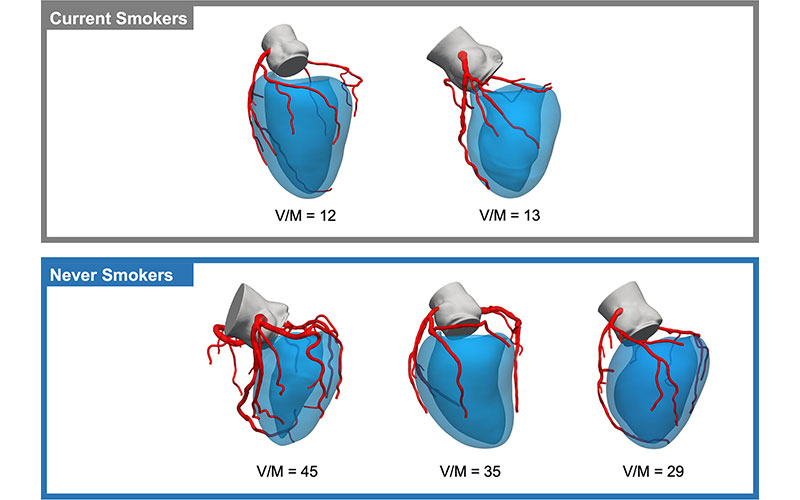Increased Myocardial Mass Drives Unfavorable Changes in Smokers’ Hearts
Heart blood vessel size was smaller in patients who currently or previously smoked


The lower ratio of coronary artery volume to myocardial mass in both current and former smokers compared with never-smokers is driven by greater myocardial mass, according to research from Radiology: Cardiothoracic Imaging.
In a healthy heart, coronary arteries deliver oxygenated blood as the myocardium demands it. But when arteries narrow with atherosclerosis, the supply and demand become mismatched. In conditions of increased oxygen need, this mismatch raises the risk of myocardial ischemia.
The ratio of coronary artery lumen volume-to-myocardial mass (V/M) is a promising marker of cardiac supply-demand mismatch. It can be calculated with CT fractional flow reserve (FFR), a minimally invasive procedure that provides a 3D view of the heart and detects limitations in blood flow due to blockages in the arteries. A low V/M suggests insufficient coronary supply for a given myocardial demand, while a higher V/M implies better coronary reserve, resulting in a lower risk of ischemia.
Research has found lower V/M in people with diseases like hypertrophic cardiac myopathy. However, the effect of smoking, a known risk factor for cardiovascular disease, on V/M is not well established.
Smoking Affects Blood Flow Even After Quitting
Canadian researchers studied this effect in participants drawn from the Assessing Diagnostic Value of Noninvasive FFRCT in Coronary Care (ADVANCE) registry. The study group included 2,874 participants with coronary stenosis of 30% or greater at coronary CT angiography (CCTA).
Of the participants, 503 were current smokers and 1,060 were former smokers. The remaining 1,311 had never smoked. All had undergone cardiac analysis with CT-FFR.
After adjustment for demographic and clinical factors, both current and former smokers had lower V/M than never-smokers.
“Most of this reduction in coronary volume to mass is driven by an increase in myocardial mass as opposed to the coronary luminal volume change,” said study senior author Stephanie Sellers, PhD, director at of the Cardiovascular Translational Laboratory at St. Paul's Hospital and Centre for Heart Lung Innovation, both in Vancouver, Canada. “These results give us new insight into how blood supply and demand is occurring within the smoking population compared to the never-smokers.”
The lower V/M in the former smokers in the study underscores how smoking’s harmful effects linger even after smoking cessation, Dr. Sellers said.
When participants were stratified by the severity of their stenosis, the differences in V/M between smoking groups remained significant only among participants with stenosis of 50% or greater.
“This suggests that the harmful effects of smoking on the coronary supply-demand balance may be more prominent in people with more advanced luminal narrowing,” Dr. Sellers said.
The mechanisms driving the increase in myocardial mass in smokers are not yet known and are a source of future investigations. Smoking’s multifaceted mechanism of action is known to include oxidative stress, inflammation and hypertension. There was no evidence of a difference in hypertension requiring treatment between current or former smokers and never-smokers in the study, and hypertension itself was not an independent predictor of lower V/M.

Sample CT fractional flow reserve models and calculated coronary volume–to–myocardial mass ratio (V/M, in cubic millimeters per gram) in current smokers and never-smokers demonstrate low and high V/M, respectively.
https://doi.org/10.1148/ryct.220197 © RSNA 2024
Giving Additional Insights into Coronary Artery Disease Pathophysiology
The study adds important insight into the pathology of heart disease in smokers, according to Marly van Assen, PhD, assistant professor at Emory University School of Medicine in Atlanta. In an editorial accompanying the study, Dr. van Assen and her Emory colleague, Carlotta Onnis, MD, said the results show the importance of myocardium evaluation in addition to assessment of the coronary arteries.
For example, CCTA only looks at luminal narrowing—the supply part of the equation.
“This study shows that the demand part in smokers is very important because the difference between the smokers and nonsmokers was mostly in the myocardial mass,” Dr. van Assen said.
While the V/M ratio has no current clinical use, in the future it has the potential to help with cardiac risk prediction.
Dr. Sellers’ colleagues are studying V/M in other populations and working to understand the biology that underpins the change in volume to mass. They also are looking at ways to improve the cardiac imaging. Patients typically receive nitroglycerine before CTFFR to improve the image quality and increase the number of coronary vessels that can be seen. The amount of nitroglycerine and the way it is administered could affect the observed V/M and may need to be standardized in the future.
“We want this test to eventually provide more insights into risk stratification and evaluation of outcomes,” Dr. Sellers said.
The V/M ratio also has promise in illuminating gender differences in heart disease. Previous research found that women tend to have a higher V/M than men, with an overall lower rate of obstructive coronary artery disease.
“It could be because women have a lower myocardial mass to a higher lumen volume ratio and thus more supply than they have demand,” Dr. van Assen said. “It would be interesting to see if smoking affects women the same way.”
For More Information
Access the Radiology: Cardiothoracic Imaging study, “Impact of Smoking on Coronary Volume–to–Myocardial Mass Ratio: An ADVANCE Registry Substudy,” and the related editorial, "Coronary Volume-to-Myocardial Mass Ratio Giving Additional Insights in Coronary Artery Disease Pathophysiology."
Read previous RSNA News stories on cardiac imaging:
- Virus that Causes COVID-19 Increases Risk of Cardiac Events
- Research Identifies Imaging Measurements and Serum Biomarkers Associated with Cardiac Strain and Myocardial Injury
- Researchers Develop New Coronary Risk Score for Women